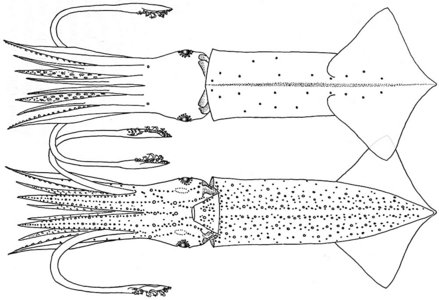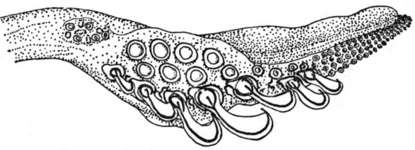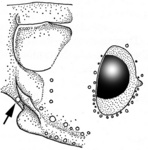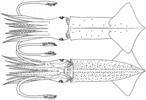Abralia spaercki
Kotaro TsuchiyaIntroduction
A. spaercki is probably a demersal mesopelagic boundary species associated with the continental or island shelves. Relationship with the allopatric A. multihamata is not fully understood.
Brief diagnosis:
An Abralia (Abralia) with ...
- peculiar photophore in the funnel groove.
- scattered photophores between medial and lateral arm photophores on arms IV.
Characteristics
- Tentacle clubs
- Five to seven hooks on ventral side.
- Two rows of large suckers on dorsal side of manus.
- Hectocotylus
- Right ventral arm of male hectocotylized.
- Hectocotylus with two different sized off-set flaps.
- Proximal part of modified portion with armature.
- Eye Photophores
- Five major complex organs: two large, terminal, opaque organs and three intermediate silvery organs; some minute additional organs present.
- Integumental Photophores
- Ventral mantle and head with relatively sparse, scattered arrangement of integumental organs.
- Within funnel groove a large, white photophore posteromedial to inner occipital fold.
Comments.
A. spaercki is very similiar to A. multihamata but has scattered photophores in the proximal half of each arm IV found between the medial and lateral (not lateral membrane) photophore series and has a single, large white photophore found in the funnel groove posteromedial to each first occipital lobe not found in A. multihamata.Distribution
Geographical distribution
Type locality - Coast of Sawrude Island, near Ambon, Banda Sea, Indonesia. A. spaercki is recorded from the shelf waters of the Philippines, Indonesia, and northern Australia.References
Voss, G.L. 1963. Cephalopods of the Philippine Islands. United States National Museum Bulletin, 234:1-180.
About This Page

Tokyo University of Fisheries, Tokyo, Japan
Page copyright © 2018
All Rights Reserved.
- Content changed 11 October 2015
Citing this page:
Tsuchiya, Kotaro. 2015. Abralia spaercki . Version 11 October 2015 (under construction). http://tolweb.org/Abralia_spaercki/19650/2015.10.11 in The Tree of Life Web Project, http://tolweb.org/















 Go to quick links
Go to quick search
Go to navigation for this section of the ToL site
Go to detailed links for the ToL site
Go to quick links
Go to quick search
Go to navigation for this section of the ToL site
Go to detailed links for the ToL site